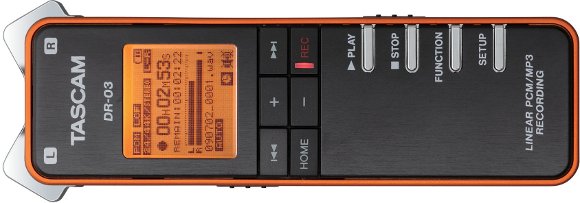
There was a time when Tascam was associated with cheap, solid mobile gear for recording, like the Portastudio. The handheld DR-03 could be a landmark for a more digital age. It’s just US$99 for a microSD recorder with built-in stereo mic in a package Tascam describes as “smaller than an energy bar.” It’s designed to be operated handheld without a lot of noise (we’ll have to test that), and – in what I think may be the killer feature – it includes looping and Variable Speed Audition, so you can use it easily as a practice, music transcription, or interview transcription tool. Just slow down the audio, without impacting the pitch.
Feature set from Tascam:
- Stereo condenser microphone design
- Up to 48kHz/24-bit WAV recording or MP3 recording modes
- Records to microSD media
- Auto-recording function starts when input exceeds a reference level
- Limiter, low cut filter and auto gain control for input
- Variable Speed Audition changes the playback speed without changing the pitch
- Loop playback mode
- USB 2.0 connection for file transfer
- 1/8″ stereo microphone/line input
- 1/8″ stereo headphone output
- 96×96 backlit LCD display
- Powered by two AAA batteries or USB bus power
- Built-in speaker
- Built-in desktop stand
- Includes 2GB microSD card and AAA batteries
Available now.
http://tascam.com/product/dr-03/
And yes, there are higher-end options from Tascam if you so choose, though that gets them into competition with Sony, Roland/Edirol, M-Audio, Korg, and Zoom, all of whom make some nice options. I’m guessing the $100 price point and pitch control option could be the winner for a lot of customers. (There are some reasons to look at the full line; the DR-03 has fixed stereo mics; on the DR-08, the stereo mic flips out like cute Mickey Mouse ears for better spatialization. I’d probably chose the -03 as a practice recorder.)
See also the awesome and likewise adorable Zoom H1:
Zoom H1 @ Samson
Big minus for the H1: no pitch control. Big plus for the H1: a shoe mount for attaching to a camera. The H1 is a little larger, so a tripod mount becomes possible. That’s probably your deciding point right there. The Tascam only works as a handheld, as it’s smaller, so you’ll have to prop it up against something or use its desktop kickstand. If transcription is your main application, the Tascam wins. If you want to be able to shoot with a camera or put it somewhere other than your hand or balanced on a ledge, the Zoom is a better choice.